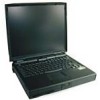Dell Inspiron 7000 Dell Inspiron 7000 Reference and Troubleshooting Guide - Page 59
procedure, perform the operation that caused the problem to see if the problem still - remove hard drive
 |
View all Dell Inspiron 7000 manuals
Add to My Manuals
Save this manual to your list of manuals |
Page 59 highlights
IRQ12 Generated by the keyboard controller to indicate that the output buffer of the integrated touch pad or external PS/2 mouse is full IRQ13 Used by the math coprocessor on the microprocessor IRQ14 Generated by the hard-disk drive to indicate that the drive requires the attention of the microprocessor IRQ15 Generated by the secondary IDE controller (CD-ROM drive) to indicated that the drive requires attention of the microprocessor. NOTE: For the full name of an abbreviation or acronym used in this table, see the Glossary in the System User's Guide. This section provides troubleshooting procedures for built-in components (such as the display) and for external devices that connect to the computer (such as an external monitor). Before performing any of the procedures in this section, see "Basic Checks" found earlier in this chapter and read the safety instructions at the front of this guide. Then perform the appropriate troubleshooting procedure for the component or equipment that is malfunctioning. NOTES: When you see the question "Is the problem resolved?" in a troubleshooting procedure, perform the operation that caused the problem to see if the problem still occurs. Before you begin any of the troubleshooting procedures, make sure the Quiet Boot option is set to Disabled in the Main menu of the Setup program. See Chapter 2, "Customizing System Features," for information on using the Setup program. Liquids, spills and splashes, rain, and excessive humidity can cause moisture damage to the computer. If the computer gets wet or if condensation forms on the computer because of humid conditions, use the following procedure. 1. Turn off the computer and disconnect it from the AC adapter. Then disconnect the AC adapter from AC power. Turn off any attached peripherals and disconnect them from their power sources and then from the computer. 2. Remove any installed batteries. Wipe off each battery and store it in a safe place to dry. Troubleshooting Your Computer 3-13















